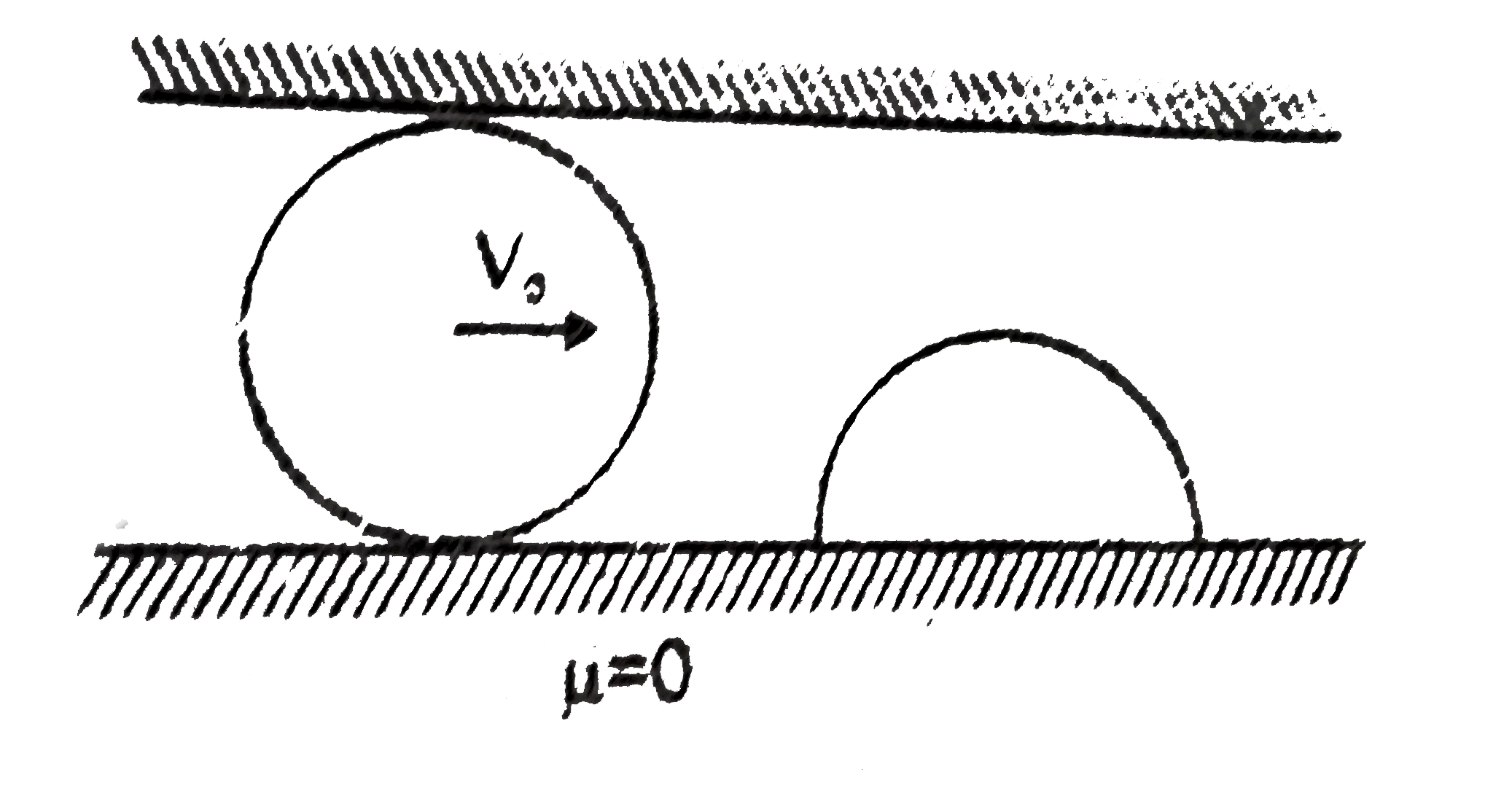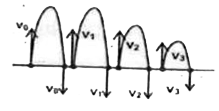A sphere of mass m falls on a smooth hemisphere of mass M resting with its plane face on smooth horizontal table, so that at the moment of impact, line joining the centres makes an angle with the vertical. The velocity of sphere just before impact is u and e is the coefficient of restitution.
The velocity of hemisphere after impact will be zero
The hemisphere will move with a velocity v=musinαMcos2α
The hemisphere will move with a velocity v=mucosα(1+e)(M+m)
None of these
The correct Answer is:C
To solve the problem step by step, we will analyze the situation using the principles of conservation of momentum and the coefficient of restitution.
Step 1: Understand the Setup
We have a sphere of mass m falling towards a smooth hemisphere of mass M. The sphere is moving with a velocity u just before impact, and the line joining the centers of the sphere and hemisphere makes an angle α with the vertical.
Step 2: Resolve the Velocity of the Sphere
Before the impact, we can resolve the velocity u of the sphere into two components:
- The vertical component: ucosα
- The horizontal component: usinα
However, since the hemisphere is smooth and can only move horizontally, we will focus on the horizontal component for momentum conservation.
Step 3: Apply Conservation of Momentum
According to the conservation of momentum, the momentum before the collision must equal the momentum after the collision. The momentum before the collision is given by the horizontal component of the sphere's velocity:
Initial momentum=m⋅ucosα
Let V be the velocity of the hemisphere after the impact and v be the velocity of the sphere after the impact. The momentum after the collision is:
Final momentum=M⋅V+m⋅v
Setting the initial momentum equal to the final momentum:
m⋅ucosα=M⋅V+m⋅v(1)
Step 4: Apply the Coefficient of Restitution
The coefficient of restitution e relates the relative velocities of the two bodies before and after the collision. It is defined as:
e=Relative velocity after collisionRelative velocity before collision
In our case, the relative velocity before the collision is ucosα (the sphere is moving towards the hemisphere). After the collision, the relative velocity is V+v (the hemisphere moves with velocity V and the sphere moves with velocity v):
e=V+vucosα(2)
From equation (2), we can express v in terms of V:
v=eucosα−V(3)
Step 5: Substitute Equation (3) into Equation (1)
Now we substitute equation (3) into equation (1):
m⋅ucosα=M⋅V+m⋅(eucosα−V)
Expanding this gives:
m⋅ucosα=M⋅V+meucosα−mV
Rearranging terms:
mucosα−meucosα=(M−m)V
Factoring out ucosα:
ucosα(m−me)=(M−m)V
Step 6: Solve for V
Now we can solve for V:
V=ucosα(m(1−e))M+m
Step 7: Final Expression
Thus, the final expression for the velocity of the hemisphere after the impact is:
V=mucosα(1+e)M+m
Conclusion
The correct option that matches our derived expression is:
Option C: V=mucosα(1+e)M+m
We have a sphere of mass m falling towards a smooth hemisphere of mass M. The sphere is moving with a velocity u just before impact, and the line joining the centers of the sphere and hemisphere makes an angle α with the vertical.
Before the impact, we can resolve the velocity u of the sphere into two components:
- The vertical component: ucosα
- The horizontal component: usinα
According to the conservation of momentum, the momentum before the collision must equal the momentum after the collision. The momentum before the collision is given by the horizontal component of the sphere's velocity:
The coefficient of restitution e relates the relative velocities of the two bodies before and after the collision. It is defined as:
Now we substitute equation (3) into equation (1):
Now we can solve for V:
Thus, the final expression for the velocity of the hemisphere after the impact is:
The correct option that matches our derived expression is:
Topper's Solved these Questions
- BOOK - VMC MODULES ENGLISHCHAPTER - ENERGY & MOMENTUMEXERCISE - LEVEL - 2 PARAGRAPH QUESTIONS2videos
ENERGY & MOMENTUM
- BOOK - VMC MODULES ENGLISHCHAPTER - ENERGY & MOMENTUMEXERCISE - JEE MAIN (ARCHIVE)53videos
ENERGY & MOMENTUM
- BOOK - VMC MODULES ENGLISHCHAPTER - ENERGY & MOMENTUMEXERCISE - Level - 1 PARAGRAPH QUESTIONS3videos
ENERGY & MOMENTUM
- BOOK - VMC MODULES ENGLISHCHAPTER - ELECTROSTATICSEXERCISE - JEE Advanced (Archive)89videos
ELECTROSTATICS
- BOOK - VMC MODULES ENGLISHCHAPTER - GASEOUS STATE & THERMODYNAMICSEXERCISE - JEE ADVANCED (ARCHIVE )111videos
GASEOUS STATE & THERMODYNAMICS
Similar Questions
A smooth hemisphere of mass m and radius R is at rest. A smooth solid sphere of mass 2m and radius R moving with velocity V0 between two horizontal smooth surfaces separated by a distance slightly greater than 2R as shown in figure. Solid sphere collides with the hemisphere. if coefficient of restitution is 12, then
 View Solution
View SolutionA sphere of mass m, impinges obliquely on a sphere, of mass M, which is at rest. Show that, if m=eM, the directions of motion of the sphere after impact are at right angles.
View SolutionA ball of mass m is projected vertically up from a smooth horizontal floor with a speed v. Find the total momentum delivered by the ball to the surface during impact assuming e as the cofficient of restitution of impact.
 View Solution
View SolutionA wedge of mass M is kept at rest on smooth surface a particle of mass m hits the wedge normally. Find the velocity of wedge and particle just after collision. Take coefficient of restitution as e.
View SolutionA hemisphere of radius R and mass 4 m is free to slide with its base on a smooth horizontal table . A particle of mass m is placed on the top of the hemisphere . The angular velocity of the particle relative to centre of hemisphere at an angular displacement θ when velocity of hemisphere has become v is
View SolutionTwo smooth spheres. A and B. having equal radii, lie on a horizontal table. A is of mass m and B is of mass 3m. The spheres are projected towards each other with velocity vector 5ˆi+2ˆj and 2ˆi−ˆj, respectively, and when they collide the lige joining their centres is parallel to the vector ˆi. If the coefficient of restitution between A and B is 1/3, find the velocities after impact and the loss in kinetic energy caused by the collision. Find also the magnitude of the impulses that act at the instant of impact.
View SolutionA smooth sphere of mass M moving with velocity u directly collides elastically with another sphere of mass m at rest. After collision their final velocities are V and v respectively. The value of v is
View SolutionA smooth sphere of mass M moving with velocity u directly collides elastically with another sphere of mass m at rest. After collision their final velocities are V and v respectively. The value of v is
View SolutionTwo equal spheres of mass m are in contact on a smooth horizontal table. A third identical sphere impinges symmetrically on the and is reduced to rest. Prove that e=23 and find the loss in KE.
View SolutionA ball of mass 2m impinges directly on a ball of mass m, which is at rest. If the velocity with which the larger ball impringes be equal to the velocity of the smaller mass after impact then the coefficient of restitution :-
View Solution

